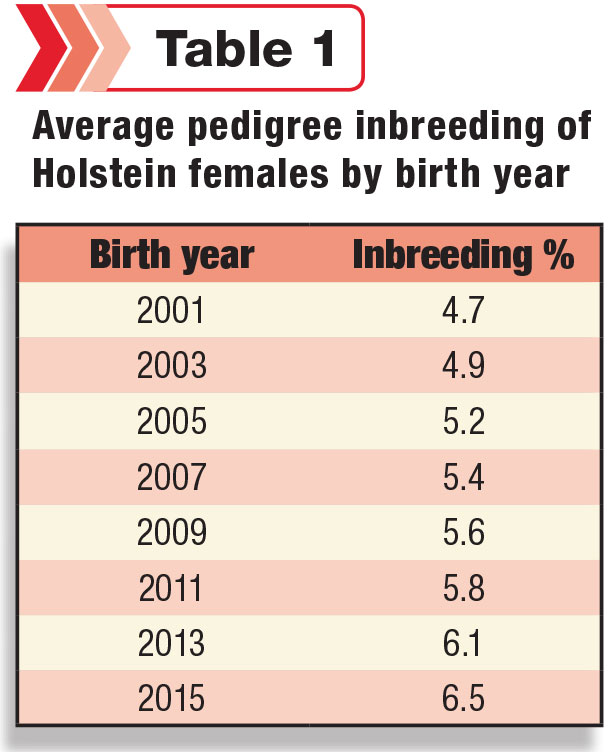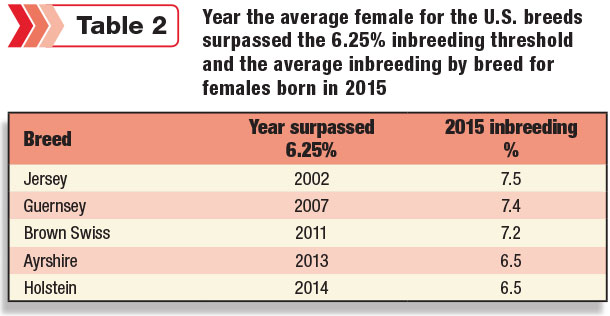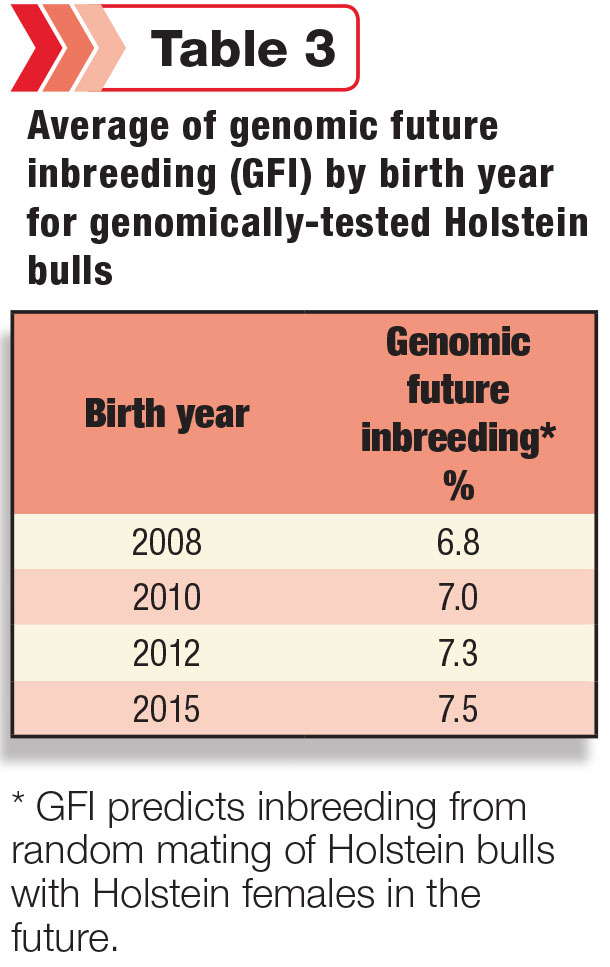Dairy producers in the U.S. typically breed their Holstein heifers and cows with semen from Holstein A.I. bulls on a random basis without regard to pedigrees and the potential for inbreeding.
Wisely, some dairy producers use the mating programs that are offered by all of the major A.I. organizations to assign A.I. bulls to females. The key justification for using mating programs is to avoid inbreeding depression in resulting offspring. But, unfortunately, the majority of Holstein to Holstein matings in the U.S. are random in regard to the pedigree of bulls versus females.
Table 1 reviews the average inbreeding of U.S. Holstein females by birth year (presented for alternate years) over the past 15 years. An increase for average inbreeding is expected within a breed that has strong genetic improvement programs.
From Table 1, the average inbreeding of Holstein females increased about 0.1 percent per year from 2001 to 2011. However, the annual increase of average inbreeding has accelerated over the past few years to about 0.2 percent per year (a doubling of the annual increase). This is a result of the broad application of genomic selection in the Holstein breed. Genomic selection dramatically shortens generation interval (the average age of parents when offspring are born), and genetic theory tells us this will accelerate the annual average increase of inbreeding within a breed. So, there is nothing surprising or unexpected about this outcome.
Read a Q&A with Dr. Les Hansen here.

What does inbreeding measure? It’s the percentage of locations where the two genes on the pairs of chromosomes are identical by descent from ancestors. An average Holstein heifer born during early 2015 has inbreeding of 6.5 percent. To put this in perspective, a cow bred to her own sire results in the offspring having inbreeding of 25 percent, and a cow bred to her half-brother (they share the same sire) results in inbreeding of 12.5 percent.
Historically, livestock geneticists have recommended that inbreeding shouldn’t surpass about 6.25 percent for individual matings to avoid inbreeding depression for commercial livestock production. Of course, the 6.25 percent threshold isn’t magical. Inbreeding depression has a progressive negative effect – especially for the traits related to fertility, health and longevity. Therefore, inbreeding of 6.4 percent for an individual mating is only slightly more of a problem than inbreeding of 6.1 percent. However, the jump in average inbreeding from 6.1 percent to 6.5 percent within just a two-year period of time for the entire Holstein breed is noteworthy, and it should catch the attention of dairy producers and their advisers and consultants.
Each of the other breeds of dairy cattle in the U.S. has previously witnessed average inbreeding surpassing 6.25 percent. Table 2 reviews the year each breed surpassed average inbreeding of 6.25 percent, as well as the breed’s average inbreeding for calves born during 2015.
One could argue that each of the non-Holstein breeds, which has a much smaller number of cows in its breed, has a more pressing concern about average inbreeding than the vast Holstein breed. However, it’s important to realize most breeders of dairy cattle of the non-Holstein breeds have a keen awareness of the need to carefully mate each heifer or cow with an A.I. bull. In other words, they seldom randomly use an A.I. bull on a female within the breed.

Therefore, dairy producers with pure Holstein cows must now also learn to appreciate the importance of maintaining accurate pedigrees of females in their herds and to recognize the need to use computerized mating programs to assign semen from A.I. bulls individually to heifers and cows. This will prevent large doses of inbreeding in individual matings. The dawn of a new day has arrived for mating Holstein bulls to Holstein females!
“Genomic future inbreeding” (GFI) is assigned to individual bulls with genetic evaluations, and GFI predicts the average inbreeding expected if a bull is randomly mated to females of the same breed. Therefore, GFI is a forward-looking prediction. Table 3 provides the average of GFI for Holstein bulls by birth year. The table begins with birth year 2008; therefore, all of the bulls included in the summary were genomically tested.
To help interpret Table 3, the random mating of Holstein females to a typical Holstein A.I. bull born in 2015 will have inbreeding of 7.5 percent. This high level of average inbreeding is completely new territory for the Holstein breed. It demonstrates the emerging importance of carefully mating Holstein A.I. bulls to Holstein females based on their pedigrees in order to avoid high doses of inbreeding in individual matings.

Mounting concern about the effects of inbreeding within the pure breeds has led some dairy producers to turn to crossbreeding systems. Crossbreeding of distinct breeds or crossing of inbred lines has been routine for commercial production of all livestock besides dairy cattle for many years. Crossbreeding eliminates concern about inbreeding depression and instead provides a boost in the form of hybrid vigor, especially for traits related to fertility, health and longevity. PD
This article was reprinted with permission.

-
Les Hansen
- Dairy Genetics Specialist
- University of Minnesota






